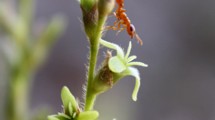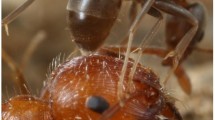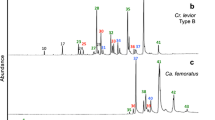Abstract
The partnership in the Crematogaster–Macaranga ant–plant interaction is highly species-specific. Because a mutualistic relationship on a Macaranga plant starts with colonization by a foundress queen of a partner Crematogaster species, we hypothesized that the foundress queens select their partner plant species by chemical recognition. We tested this hypothesis with four sympatric Macaranga species and their Crematogaster plant-ant species. We demonstrated that foundress Crematogaster queens can recognize their partner Macaranga species by contact with the surface of the seedlings, that they can recognize compounds from the stem surface of seedlings of their partner plant species, and that the gas chromatographic profiles are characteristic of the plant species. These findings support the hypothesis that foundress queens of the Crematogaster plant-ant species select their partner Macaranga species by recognizing nonvolatile chemical characteristics of the stem surfaces of seedlings.
Similar content being viewed by others
REFERENCES
BONAVITA, C. A., CLÈMENT, J. L., and LANGE, C. 1987. Nestmate recognition: The role of cuticular hydrocarbons in ant Camponotus vagus Scop. J. Entomol. Sci. 22:1-10.
BUCKLEY, R. C. 1982. Ant-Plant Interactions in Australia. Dr. W. Junk Publishers, The Hague, The Netherlands.
DAVIDSON, D. W. and MCKEY, D. 1993. The evolutionary ecology of symbiotic ant-plant relationships. J. Hym. Res. 2:13-83.
DAVIES, S. J., PALMIOTTO, P. A., ASHTON, P. S., LEE, H. S., and LAFRANKIE, J. V. 1998. Comparative ecology of 11 sympatric species of Macaranga in Borneo:Tree distribution in relation to horizontal and vertical resource heterogeneity. J. Ecol. 86:662-673.
FIALA, B. and MASCHWITZ, U. 1990. Studies on the South East Asian ant-plant association C. borneeensis-Macaranga: Adaptations of the ant-partner. Insectes Soc. 37:212-231.
FIALA, B. and MASCHWITZ, U. 1991. Extrafloral nectaries in genus Macaranga (Euphorbiaceae) in Malaysia: Comparative studies of their possible significance as predispositions for myrmecophytism. Biol. J. Linn. Soc. 44:287-305.
FIALA, B. and MASCHWITZ, U. 1992a. Domatia as most important adaptations in the evolution of myrmecophytes in the paleotropical tree genus Macaranga (Euphrobiaceae). Plant Syst. Evol. 180:53-64.
FIALA, B. and MASCHWITZ, U. 1992b. Food bodies and their significance for obligate ant-association in the tree genus Macaranga (Euphorbiaceae). Bot. J. Linn. Soc. 110:61-75.
FIALA, B., MASCHWITZ, U., THO, Y. P., and HELBIG, A. J. 1989. Studies of a South East Asian ant-plant association: Protection of Macaranga trees by Crematogaster borneensis. Oecologia 79:463-470.
FIALA, B., JACOB, A., MASCHWITZ, U., and LINSENMAIR, E. 1999. Diversity, evolutionary specialization and geographic distribution of a mutualistic ant-plant complex: Macaranga and Crematogaster in South East Asia. Biol. J. Linn. Soc. 66:305-331.
HEIL, M., FIALA, B., LINSENMAIR, K. E., ZOTZ, G., MENKE, P., and MASCHWITZ, U. 1997. Food body production in Macaranga triloba (Euphorbiaceae): A plant investment in antiherbivore defence via symbiotic ant partners. J. Ecol. 85:847-861.
HöLLDOBLER, B. and CARLIN, N. F. 1987. Anatomy and specificity in the chemical communication signals of social insects. J. Comp. Physiol. A. 161:567-581.
HUXLEY, C. R. and CUTLER, D. F. 1991. Ant-Plant Interactions, Oxford University Press, New York.
INOUE, T. and HAMID, A. A. 1994. Plant Reproductive System and Animal Seasonal Dynamics (Long-Term Study of Dipterocarp Forests in Sarawak). Center for Ecological Research,Kyoto University, Otsu, Japan.
ITIOKA, T., NOMURA, M., INUI, Y., ITINO, T., and INOUE, T. 2000. Difference in intensity of ant defense among three species of Macaranga myrmecophytes in a Southeast Asian dipterocarp forest. Biotropica 32:318-326.
JANZEN, D. H. 1966. Coevolution of mutualism between ants and acacias in Central America. Evolution 20:249-275.
JESSEN, K. and MASCHWITZ, U. 1986. Orientation and recruitment behavior in the ponerine ant Pachycondyla tesserinoda (Emery): Laying of individual-specific trails during tandem running. Behav. Ecol. Sciobiol. 19:151-155.
KATO, M., INOUE, T., HAMID, A. A., NAGAMASU, T., MERDEK, M. B., NONA, A. R., ITINO, T., YAMANE, S. K., and YUMOTO, T. 1995. Seasonality and vertical structure of light-attracted insect communities in a dipterocarp forest in Sarawak. Res. Pop. Ecol. 37:59-79.
MCKEY, D. and DAVIDSON, D. W. 1993. Ant-plant symbioses in Africa and the neotropics: History, biogeography and diversity, pp. 568-606, in P. Goldblatt (ed.). Biological Relationships between Africa and South America. Yale University Press, New Haven, Connecticut.
NAGAMASU, H. and MOMOSE, K. 1997. Flora of Lambir Hills National Park, Sarawak, with special reference to the Canopy Biology Plot, pp. 20-67, in T. Inoue and A. A. Hamid (eds.). General Flowering of Tropical Rainforests in Sarawak. Center for Ecological Research, Kyoto University, Otsu, Japan.
NOMURA, M., ITIOKA, T., and ITINO, T. 2000. Variations in abiotic defense within myrmecophytic and non-myrmecophytic species of Macaranga in a Bornean dipterocarp forest. Ecol. Res. 15:1-11.
RICKSON, F. R. 1980. Developmental anatomy and ultrastructure of the ant-food bodies of Macaranga triloba and M. hypoleuca. Am. J. Bot. 67:285-292.
TRANIELLO, J. F. A. 1980. Colony specificity in the trail pheromone of an ant. Naturwissenschaften 67:361-362.
WATSON, H. 1985. Lambir Hills National Park: Resource Inventory with Management Recommendations. National Parks and Wildlife Office, Forest Department, Kuching, Sarawak, Malaysia.
WHITMORE, T. C. 1969. First thoughts on species evolution in Malayan Macaranga (Studies in Macaranga III). Biol. J. Linn. Soc. 1:223-231.
YU, D. W. and DAVIDSON, D. W. 1997. Experimental studies of species-specificity in Cecropia-ant relationships. Ecol. Monogr. 67:273-294.
Author information
Authors and Affiliations
Rights and permissions
About this article
Cite this article
Inui, Y., Itioka, T., Murase, K. et al. Chemical Recognition of Partner Plant Species by Foundress Ant Queens in Macaranga–Crematogaster Myrmecophytism. J Chem Ecol 27, 2029–2040 (2001). https://doi.org/10.1023/A:1012290820150
Issue Date:
DOI: https://doi.org/10.1023/A:1012290820150




